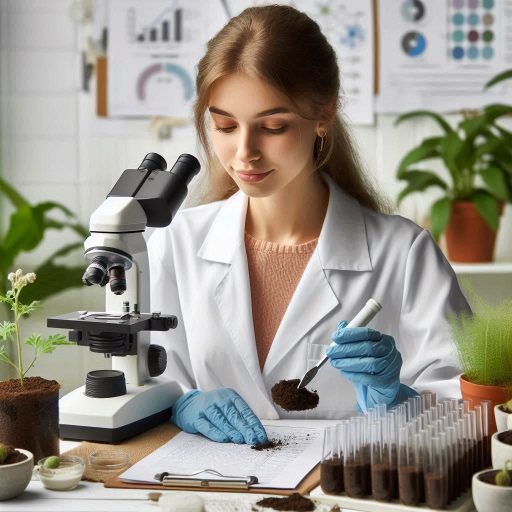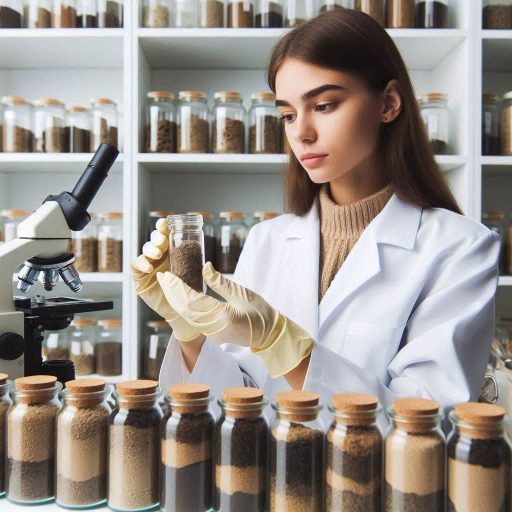Introduction
Soil scientists and agronomists play vital roles in modern agriculture.
They contribute to enhancing soil health, crop production, and food security.
Their work impacts farming practices and environmental sustainability.
Despite their importance, many people confuse soil scientists with agronomists.
While both professions focus on agriculture, their roles and areas of expertise differ significantly.
This confusion can lead to misunderstandings about their contributions to farming.
Soil scientists specialize in studying the properties and processes of soil.
They analyze soil composition, fertility, and health.
Their work helps develop sustainable practices that improve soil quality and conservation.
Agronomists, on the other hand, focus on crop production and management.
They advise farmers on various aspects of farming, including crop selection and pest management.
Agronomists aim to maximize yields while minimizing environmental impact.
This blog will outline the key differences between soil scientists and agronomists.
We will explore their education, focus areas, job responsibilities, tools, and collaborative efforts.
Understanding these distinctions is crucial for appreciating the vital contributions each profession makes to agriculture and food security.
Education and Training
Education and training play vital roles in shaping the careers of soil scientists and agronomists.
While both professionals focus on agriculture, their educational backgrounds differ significantly.
Understanding these differences helps clarify their roles and contributions to agricultural science.
Soil Scientists Typically Have a Background in Soil Science, Geology, or Environmental Science
Soil scientists typically possess a background in soil science, geology, or environmental science.
Their education emphasizes the study of soil properties, behavior, and management.
Most soil scientists hold a bachelor’s degree in soil science or a closely related field.
Many pursue advanced degrees to specialize further.
During their studies, soil scientists learn about soil formation processes and classifications.
They study soil chemistry, microbiology, and physics to understand how soils function.
This knowledge allows them to assess soil health and recommend management practices.
Soil scientists often engage in fieldwork, laboratory analysis, and research projects.
Their training equips them to evaluate soil for various uses, including agriculture and environmental conservation.
Agronomists Usually Have a Degree in Agronomy, Crop Science, or a Related Field
Agronomists, on the other hand, usually earn a degree in agronomy, crop science, or a related field.
Their education focuses on crop production, soil fertility, and pest management.
A bachelor’s degree is often sufficient for entry-level positions, but many agronomists also pursue advanced degrees.
Agronomy programs emphasize the study of plant growth, breeding, and cultivation techniques.
Agronomists learn about the interactions between crops and soils, including nutrient management and irrigation practices.
This knowledge helps them optimize crop yields and ensure sustainable farming.
Additionally, agronomists receive training in the use of agricultural technology.
They learn about precision agriculture techniques, which enhance crop management.
This training allows them to implement innovative practices that improve productivity.
Differences in Coursework and Specialization Between the Two Professions
The coursework for soil scientists and agronomists differs significantly.
Soil scientists concentrate on soil-related subjects, while agronomists focus on crops and agricultural systems.
Soil science courses may cover topics like soil classification, mineralogy, and soil-water relationships.
In contrast, agronomy courses typically address crop physiology, pest management, and sustainable agriculture practices.
Both professions may take overlapping courses, particularly in areas like soil fertility and environmental science.
However, the emphasis on soil versus crops distinguishes their education.
Soil scientists delve deeper into the complexities of soil ecosystems, while agronomists explore crop production methods.
Moreover, soil scientists often specialize in areas like soil conservation or soil remediation.
Agronomists may focus on crop breeding, agronomic research, or sustainable practices.
These specializations further illustrate the different career paths available in agricultural science.
Soil scientists and agronomists have distinct educational backgrounds and training.
Soil scientists emphasize soil properties and management, while agronomists focus on crop production and agricultural practices.
Understanding these differences helps clarify the roles each profession plays in advancing agricultural science.
Read: U.S. Cities with the Most Opportunities for Environmental Scientists
Focus and Scope of Work
Soil scientists and agronomists have distinct focuses and scopes of work.
Understanding their roles helps clarify their contributions to agriculture and environmental science.
Each profession addresses different aspects of soil and crop management, leading to varied research areas and career paths.
Soil Scientists Study the Physical, Chemical, and Biological Properties of Soil
Soil scientists primarily study the physical, chemical, and biological properties of soil.
They analyze soil composition, texture, and structure to understand soil health.
This knowledge allows them to assess how soils interact with water, nutrients, and microorganisms.
Soil scientists conduct field studies and laboratory analyses to gather data.
They measure soil properties like pH, moisture content, and nutrient levels.
This information helps them determine soil fertility and recommend appropriate management practices.
Additionally, soil scientists investigate soil erosion, contamination, and degradation.
They study the impact of human activities on soil health and ecosystems.
By understanding these processes, they develop strategies to mitigate soil degradation and enhance conservation efforts.
Soil scientists often collaborate with environmental scientists and land managers.
Their work contributes to sustainable land use practices and environmental protection.
They play a crucial role in addressing issues like climate change and soil pollution.
Agronomists Focus on Crop Production, Soil Management, and Sustainable Agriculture Practices
Agronomists, in contrast, focus on crop production, soil management, and sustainable agriculture practices.
Their primary goal is to optimize crop yields while minimizing environmental impact.
Agronomists assess how different crops interact with soil and environmental factors.
They conduct experiments to evaluate various cultivation techniques, pest control methods, and fertilizer applications.
Agronomists study crop rotation, cover cropping, and integrated pest management to enhance sustainability.
They aim to increase food production without harming the environment.
Agronomists also work closely with farmers to provide guidance on best practices.
They help farmers select suitable crops based on soil conditions and climate.
Their expertise ensures that agricultural practices align with sustainable development goals.
Varied Research Areas and Career Paths Within Each Profession
The research areas and career paths within soil science and agronomy vary significantly.
Soil scientists may specialize in soil conservation, soil microbiology, or land reclamation.
They often work in academic research, government agencies, or environmental consulting.
Agronomists may focus on crop breeding, agroecology, or precision agriculture.
They often find employment in agricultural extension services, private industry, or research institutions.
Both professions offer opportunities for interdisciplinary collaboration and research.
Additionally, soil scientists and agronomists can work in policy development and advocacy.
They may engage with governmental organizations to promote sustainable agricultural practices and soil conservation.
Soil scientists and agronomists have different focuses and scopes of work.
Soil scientists study soil properties and health, while agronomists focus on crop production and sustainable practices.
Understanding these distinctions helps highlight their vital contributions to advancing agriculture and environmental sustainability.
Read: Environmental Scientist vs. Ecologist: Roles and Differences in the US
Job Responsibilities
Soil scientists and agronomists have distinct job responsibilities that reflect their focus areas.
Each plays a critical role in the agricultural industry.
Understanding their specific duties helps clarify how they contribute to farm productivity and sustainability.
Soil Scientists Analyze Soil Samples, Conduct Field Surveys, and Investigate Soil Quality
Soil scientists analyze soil samples to assess their physical and chemical properties.
They collect samples from various depths and locations for comprehensive analysis.
By examining these samples, they determine essential factors like nutrient content and pH levels.
Conducting field surveys is another vital responsibility of soil scientists.
They evaluate soil types and characteristics across different landscapes.
This information helps them understand regional soil health and inform management practices.
Investigating soil quality is crucial for maintaining healthy ecosystems.
Soil scientists study factors like organic matter content and microbial activity.
By evaluating soil health, they can recommend practices that enhance fertility and productivity.
Additionally, soil scientists may monitor the effects of agricultural practices on soil quality.
They assess how various farming methods impact soil health and sustainability.
Their findings help develop strategies to mitigate soil degradation and improve land use.
Agronomists Advise Farmers on Crop Selection, Soil Fertility, and Pest Management
Agronomists play a different yet equally important role in agriculture.
They advise farmers on crop selection based on soil characteristics and climate conditions.
This guidance helps farmers choose the most suitable crops for their land.
Soil fertility management is another key responsibility for agronomists.
They analyze soil tests to determine nutrient deficiencies.
Based on their findings, agronomists recommend appropriate fertilizers and amendments to enhance soil fertility.
In addition to soil management, agronomists focus on pest management strategies.
They educate farmers on integrated pest management practices to minimize crop damage.
This approach combines biological, cultural, and chemical methods for effective pest control.
Agronomists also conduct field trials to evaluate the effectiveness of different crops and practices.
They gather data to support their recommendations, helping farmers optimize yields.
Their research fosters sustainable agricultural practices that benefit both farmers and the environment.
Contrasting Roles in the Agricultural Industry and Impact on Farm Productivity
The contrasting roles of soil scientists and agronomists create a dynamic partnership in agriculture.
Soil scientists provide the foundational knowledge of soil health, which is crucial for crop production.
Their research informs agronomists’ recommendations, ensuring farmers make data-driven decisions.
Agronomists, in turn, apply this knowledge to enhance farm productivity.
Their direct interactions with farmers help implement effective practices on the ground.
This collaboration ultimately improves crop yields, soil health, and sustainability.
Soil scientists and agronomists have distinct but complementary job responsibilities.
Soil scientists focus on analyzing soil samples and investigating soil quality.
Agronomists advise farmers on crop selection, soil fertility, and pest management.
Together, they significantly impact agricultural practices and farm productivity.
Read: The Relationship Between U.S. Policy & Environmental Scientist Roles

Tools and Techniques
Soil scientists and agronomists utilize various tools and techniques in their work.
These instruments help them collect data, analyze findings, and make informed decisions.
Understanding their specific tools enhances our knowledge of how each profession operates within agriculture.
Soil Scientists Use Lab Equipment, Soil Sampling Tools, and Geographic Information Systems (GIS)
Soil scientists rely on advanced lab equipment to analyze soil samples.
They use spectrometers to measure soil composition and nutrient levels.
This analysis provides essential data for understanding soil health and fertility.
Soil sampling tools are crucial for collecting representative soil samples.
Soil augers and cores allow scientists to extract samples from various depths.
These tools help them assess soil properties across different locations.
Geographic Information Systems (GIS) play a vital role in soil science.
Soil scientists use GIS to map soil distribution and analyze spatial data.
This technology helps identify soil types and predict their behavior in different environments.
Additionally, soil scientists employ software to model soil processes.
These models simulate soil behavior under various conditions, such as climate change or land use changes.
This information aids in developing effective management strategies.
Agronomists Utilize Crop Modeling Software, Precision Agriculture Technology, and Field Sensors
Agronomists utilize crop modeling software to predict crop performance.
These models incorporate data on weather, soil, and crop varieties.
Agronomists use this information to optimize planting schedules and resource allocation.
Precision agriculture technology is essential for agronomists to enhance productivity.
They employ GPS-guided equipment for accurate planting and harvesting.
This technology minimizes waste and improves efficiency in agricultural operations.
Field sensors are also vital tools for agronomists.
These sensors monitor soil moisture, temperature, and nutrient levels in real-time.
By collecting data on these parameters, agronomists can make timely decisions regarding irrigation and fertilization.
Agronomists often integrate data from various sources to inform their decisions.
They analyze field data alongside weather forecasts and market trends.
This comprehensive approach enables them to adapt quickly to changing conditions.
Varied Approaches to Data Collection, Analysis, and Decision-Making in Their Respective Fields
The tools and techniques used by soil scientists and agronomists reflect their unique approaches to data collection and analysis.
Soil scientists focus on understanding soil properties through laboratory analysis and field surveys.
Their work emphasizes soil health and ecosystem function.
In contrast, agronomists prioritize optimizing crop production and sustainability.
They rely on advanced technologies and software to analyze data and improve decision-making.
Their tools allow for real-time monitoring and precise management of agricultural practices.
Both professions contribute to sustainable agriculture through their distinct methodologies.
Soil scientists provide essential data on soil health, while agronomists apply this information to improve crop management.
Their varied approaches enhance agricultural productivity and environmental stewardship.
Soil scientists and agronomists use different tools and techniques in their work.
Soil scientists rely on lab equipment, soil sampling tools, and GIS.
Agronomists utilize crop modeling software, precision agriculture technology, and field sensors.
Together, these approaches advance agricultural science and promote sustainable practices.
Transform Your Career Today
Unlock a personalized career strategy that drives real results. Get tailored advice and a roadmap designed just for you.
Start NowRead: Organizations & Associations for Environmental Scientists in the USA
Collaboration and Interdisciplinary Work
Collaboration is crucial in both soil science and agronomy.
Soil scientists and agronomists often engage with various professionals to tackle agricultural challenges.
This interdisciplinary teamwork enhances understanding and drives innovation in the field.
Soil Scientists Collaborate with Geologists, Biologists, and Environmental Scientists
Soil scientists frequently work with geologists to understand soil formation processes.
Geologists provide insights into the geological factors that influence soil development.
This collaboration helps identify soil types and their characteristics.
Biologists play a vital role in soil science as well.
Soil scientists partner with biologists to study soil microorganisms and their impact on soil health.
Understanding these relationships enhances efforts to promote sustainable soil management practices.
Environmental scientists also collaborate with soil scientists.
They address issues related to soil contamination and degradation.
This teamwork focuses on developing strategies to restore and protect soil health in contaminated areas.
Through these collaborations, soil scientists gain a broader perspective on soil systems.
They integrate knowledge from various disciplines to enhance research outcomes.
This interdisciplinary approach fosters innovative solutions to complex soil-related challenges.
Agronomists Work Closely with Farmers, Plant Breeders, and Agricultural Engineers
Agronomists engage closely with farmers to improve crop production practices.
They provide farmers with advice on crop selection, soil management, and pest control.
This direct collaboration ensures that agronomists understand farmers’ needs and challenges.
Plant breeders also collaborate with agronomists to develop improved crop varieties.
Agronomists provide insights into soil conditions and climatic factors that affect crop growth.
This partnership leads to the development of resilient crops tailored to specific environments.
Agricultural engineers work alongside agronomists to design efficient farming systems.
They develop technologies and equipment that enhance agricultural productivity.
Together, they create solutions that improve soil health and resource management.
By working with these professionals, agronomists can implement evidence-based practices.
Their collaborations lead to sustainable farming methods that benefit both the environment and farmers.
Importance of Interdisciplinary Teamwork in Addressing Complex Agricultural Challenges
Interdisciplinary teamwork is essential in addressing complex agricultural challenges.
Soil scientists and agronomists tackle issues like soil degradation, climate change, and food security.
Collaborating across disciplines enhances their ability to develop comprehensive solutions.
These partnerships foster innovation by combining diverse expertise.
Each discipline brings unique perspectives and skills to the table.
This diversity encourages creative problem-solving and promotes effective decision-making.
Furthermore, interdisciplinary collaboration improves communication among professionals.
It allows for the sharing of knowledge and resources, leading to more efficient research efforts.
Such teamwork enhances the overall effectiveness of agricultural research.
Collaboration and interdisciplinary work play significant roles in soil science and agronomy.
Soil scientists collaborate with geologists, biologists, and environmental scientists.
Agronomists work closely with farmers, plant breeders, and agricultural engineers.
This teamwork is vital in addressing complex agricultural challenges and promoting sustainable practices.
Career Opportunities
Career opportunities in soil science and agronomy are diverse and rewarding.
Both fields offer various pathways for professionals passionate about agriculture.
Understanding these career options can help aspiring scientists and agronomists make informed decisions.
Soil Scientists Can Work in Research Institutions, Government Agencies, or Environmental Consulting Firms
Soil scientists often find positions in research institutions.
These roles involve conducting experiments and publishing findings related to soil health and management.
Research institutions also provide opportunities for collaboration with other scientists.
Many soil scientists work for government agencies.
These positions focus on developing policies for soil conservation and management.
Soil scientists provide valuable data to inform environmental regulations and land use planning.
Environmental consulting firms also hire soil scientists.
In these roles, they assess soil contamination and provide remediation strategies.
Soil scientists help clients comply with environmental regulations and improve land health.
Overall, soil scientists have diverse job prospects.
They can choose to work in academia, government, or private industry.
Each path offers unique challenges and opportunities for professional growth.
Agronomists May Find Employment in Seed Companies, Extension Services, or Agribusiness Corporations
Agronomists typically find roles in seed companies.
They work on developing new crop varieties and improving existing ones.
Their research focuses on traits like yield, disease resistance, and drought tolerance.
Extension services also employ agronomists to support farmers.
These professionals provide education and resources on best practices in crop production.
They help farmers implement sustainable practices and improve their productivity.
Agribusiness corporations often hire agronomists for various roles.
These positions may involve research, marketing, or technical support.
Agronomists play a critical role in developing products that enhance agricultural productivity.
Agronomists have a range of employment opportunities.
They can work in seed companies, extension services, or agribusiness corporations.
Each role allows them to impact the agricultural sector positively.
Diverse Career Paths and Growth Opportunities Within the Agricultural Sector for Both Professions
Both soil scientists and agronomists enjoy diverse career paths in the agricultural sector.
As agriculture evolves, new job opportunities continue to emerge.
This growth stems from advancements in technology, sustainability, and environmental awareness.
Professionals in both fields can specialize in various areas.
Soil scientists may focus on soil remediation, conservation, or research.
Agronomists can specialize in crop breeding, soil management, or precision agriculture.
Continuous learning is essential in these fields.
Professionals must stay updated on industry trends and research breakthroughs.
This commitment enhances their skills and keeps them competitive in the job market.
Networking is also crucial for career advancement.
Attending conferences and joining professional organizations can lead to new opportunities.
Building relationships with peers can open doors to collaborations and job offers.
Career opportunities in soil science and agronomy are diverse and growing.
Soil scientists can work in research institutions, government agencies, or consulting firms.
Agronomists may find employment in seed companies, extension services, or agribusiness.
Both professions offer various paths and opportunities for growth within the agricultural sector.
Impact on Sustainability and Food Security
Soil scientists and agronomists play vital roles in promoting sustainability and ensuring food security.
Their combined efforts contribute significantly to the long-term viability of agriculture.
Understanding their impact highlights the importance of these professions.
Soil Scientists Study Soil Health and Conservation Practices to Promote Sustainable Agriculture
Soil scientists focus on studying soil health.
They assess soil quality and identify factors affecting its fertility.
This knowledge is crucial for developing effective conservation practices.
These scientists investigate the impact of agricultural practices on soil ecosystems.
They conduct research on erosion control, nutrient management, and soil restoration.
Their findings guide farmers in implementing sustainable practices that enhance soil health.
Soil scientists also promote conservation practices.
They recommend cover cropping, crop rotation, and reduced tillage.
These practices improve soil structure, increase organic matter, and enhance biodiversity.
Through their work, soil scientists contribute to sustainable agriculture.
Their research supports the development of practices that protect soil health.
This, in turn, fosters resilience in agricultural systems.
Agronomists Develop Strategies for Improving Crop Yields, Reducing Environmental Impact, and Ensuring Food Security
Agronomists focus on maximizing crop production while minimizing environmental impact.
They develop strategies that enhance crop yields and improve resource efficiency.
Their research addresses challenges like pest management, soil fertility, and water conservation.
These professionals evaluate various cropping systems and their sustainability.
Agronomists assess the effectiveness of precision agriculture technologies.
They identify best practices that improve productivity and reduce chemical inputs.
In addition to increasing yields, agronomists prioritize food security.
They work to ensure that agricultural systems can sustainably meet the growing global demand for food.
This involves developing resilient crops and optimizing production practices.
Combined Efforts of Both Professions Contribute to the Long-Term Viability of Agriculture and Food Production
The collaboration between soil scientists and agronomists is crucial for sustainable agriculture.
Their combined expertise addresses complex agricultural challenges effectively.
Together, they enhance the understanding of soil-plant interactions and their implications for food production.
These professionals work together to implement integrated soil and crop management strategies.
Their efforts improve soil health while increasing agricultural productivity.
This synergy supports farmers in adopting sustainable practices that protect resources.
Moreover, their work fosters innovation in agricultural technologies.
They explore new methods for monitoring soil health and managing crops.
These innovations contribute to more efficient and sustainable agricultural systems.
Ultimately, the impact of soil scientists and agronomists extends beyond their individual fields.
Together, they contribute to the long-term viability of agriculture and food production.
Their dedication to sustainability ensures a resilient future for food systems worldwide.
Soil scientists study soil health and conservation practices.
Agronomists develop strategies for improving crop yields and food security.
Their combined efforts significantly impact sustainability and food security, making them vital to agriculture’s future.
Conclusion
Soil scientists and agronomists have distinct but complementary roles in agriculture.
Soil scientists specialize in studying soil health and conservation.
They analyze soil properties and develop sustainable management practices.
Agronomists focus on crop production and improving agricultural practices.
They advise farmers on crop selection and management strategies.
Both professions contribute to enhancing food security and sustainability.
Their collaboration is vital in addressing global agricultural challenges.
By combining their expertise, they can develop innovative solutions for sustainable farming.
Together, they tackle issues like soil degradation, climate change, and resource management.
The need for further research is essential.
Continuous advancements in soil science and agronomy can significantly improve agricultural productivity.
Collaborative projects can lead to new insights and practical applications for farmers.
Encouraging partnerships between soil scientists and agronomists can enhance sustainability in agriculture.
These combined efforts can promote healthier soils and higher crop yields.
Investing in research and collaboration will foster a resilient agricultural system for the future.
In summary, recognizing the key differences and strengths of both professions is crucial.
Together, soil scientists and agronomists can create a more sustainable and productive agricultural landscape.
Their collective efforts are essential for meeting the world’s food demands.
[E-Books for Sale]
The Big Book of 500 High-Paying Jobs in America: Unlock Your Earning Potential
$19.99 • 500 High-Paying Jobs • 330 pages
Explore 500 high-paying jobs in America and learn how to boost your career, earn more, and achieve success!
See All 500 High-Paying Jobs of this E-Book
1001 Professions Without a Degree: High-Paying American Jobs You Can Start Now
$19.99 • 1001 Professions Without a Degree • 174 pages
Discover 1001 high-paying jobs without a degree! Unlock career tips, skills, and success strategies for just $19.99!




